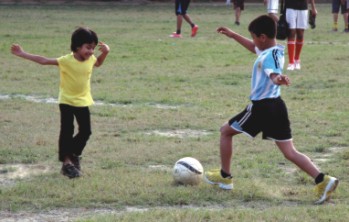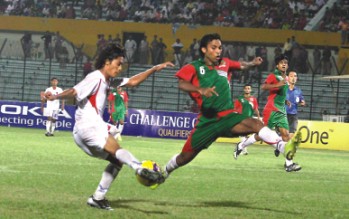|
Sport
Football's Second Wind
Syed Zain Al-mahmood
 |
The challenge is to get youngsters excited about football. |
There used to be a time when football was the heart-throb of sports fans in Bangladesh. Youngsters started games in every available open space, and even on the streets. The national stadium was the focus of attention on weekends as the top clubs of the football league did battle. Salahuddin, Salam, Badal, Chunnu and Kaiser Hamid were household names. Foreign footballers flocked to Dhaka to showcase their talents. The Nigerians Emeka and Chibuzar, Iranian stars Nalzegar and Tahiri and the Sri Lankan player Pakir Ali were but a few who delighted the local football fans with their sublime skills. Even Iran's world cup star Naser Hejazi once graced the touchline for one of Dhaka's elite football clubs. Those were the heady days for football.
Then somehow the wheels came off. Mismanagement and lack of vision took its toll. Stadium attendance dwindled, and sponsorship dried up. It seemed the wind had gone out of football's sails. While India, Thailand and Vietnam forged ahead, Bangladesh languished near the foot of the FIFA rankings. Bangladeshi clubs became the whipping boys of regional tournaments. Dhaka Abahani's victory in the Nagji Trophy Football Tournament held in India in 1990, and Mohammedan's triumph in the Ashis-Jabbar Shield Tournament in West Bengal in 1982 seemed like a distant memory. Football was on its last legs.
During this period, cricket deservedly took centre stage. The exploits of Habibul Bashar, Ashraful et al riveted the nation's attention. The cricket craze was fueled by some notable successes including victory against world champions Australia. In football terms that would be the equivalent of beating Brazil over 90 minutes. Football fans could only dream of such intoxicating triumphs, as the world's most popular game lost its appeal.
“It was as if football in Bangladesh was slowly suffocating,” says Lokman, who used to play for Arambagh Krira Chakra. “It was out of fashion, the forgotten sport. Youngsters know the names of English Premier League stars, but hardly anyone knows the names of national team players these days.”
Experts say there is a shortage of “galacticos” or star players whom people will flock to see. Thanks to cable TV, football aficionados in Bangladesh watch world class players like Ronaldo, Lampard and Torres perform week in and week out. After that, the exploits of Jahid Hasan Emily & Co. can hardly set the pulse racing.
“Cricket fans have seen superstars like Wasim Akram and Jayasurya turn out for local clubs,” says Prof. Dr. Nizamuddin Ahmed of Mohammedan Sporting Club. “Is it any wonder that cricket has caught people's fancy? We need to bring back the excitement to football.”
Getting the fans excited again may prove to be a Herculean task. Poor infrastructure, lack of sponsorship, and myopic leadership pose formidable barriers. Footballers get paid much less compared to cricketers, and sponsors have for years shied away from bankrolling football tournaments. A glaring example is the suspension of the high profile Aga Khan Gold Cup. The last Aga Khan Cup was held in 1982.
 |
| Bangladesh's tactical weakness was exposed against Myanmar. |
Recently, a sort of tentative revival seems underway. After decades of being run by bureaucrats who cared more for lucrative foreign trips than reviving football, the Football Federation is led by a panel of former players. At the helm is Kazi Salahuddin, arguably Bangladesh's best ever footballer. Former Mohammedan star Abdus Salam Murshedy is his able deputy. It remains to be seen whether the rejuvenated leadership can revitalize the sport. But they have made a positive start. Salahuddin, a feisty and skilful striker in his heyday, brings to the game the same passion as an administrator.
“I have been trying to motivate the whole social structure of developing football,” said the BFF President in a recent interview. “Clubs, players, people and media have shown their support and if everyone works like this, it won't be difficult.”
The optimism is not entirely unfounded. From the professional B League to the lavishly sponsored Citycell Super Cup, the beginning of a revival is in plain view. The Super Cup was a rousing success. Mohammedan Sporting Club beat arch rivals Abahani to lift the Tk. One Crore trophy. Organisers said the final brought the highest turnout to the Bangabandhu National Stadium in six years.
“It was like the good old days,” recalls Asif Khan, a Mohammedan fan. “The rivalry between the two top clubs used to draw huge crowds. That rivalry died down and the spark seemed to go out of the club football scene. I was delighted to see the National Stadium filled to the brim with football fans again.”
The national team has also done its bit to generate some excitement. Bangladesh became group runners-up in Group A of the recently held AFC Challenge Cup, finishing behind Myanmar but still proceeding to the next round. The Bangladesh team beat Cambodia and Macau in style to lift the spirits of local football fans.
But despite the success, the game against Myanmar exposed the lack of fitness and positional sense of Bangladeshi players. Bangladesh's Brazilian coach Edson Silva Dido called for patience, and stressed that his charges were improving. “They have improved a lot, but when one is used to eating with his left hand, it is hard to make him eat with the right,” said the Brazilian tactician in a telling comment.
Skeptics say Bangladeshis lack the physique to make a real mark on the world stage. But Dr. Nizamuddin believes this is not an insurmountable barrier. “Look at the Japanese and the Koreans,” he says. “They are of a small build as well. They do well in the world cup. Park Ji Sung of South Korea is playing for Manchester United at the highest level.”
If football is to be revived, it must be done from the bottom up, and in order to bring genuinely talented football players up through the ranks, it is vital to have a strong grassroots competition. The BFF took a step in the right direction by launching the Citycell National School Championship on May 2.
“This is my favourite tournament,” said Kazi Salahuddin. “I myself was a product of school football. This is where our future lies.”
The positive movement at the top is beginning to have an effect. At the training ground of Abahani Krira Chakra, three time winner of the B League, the smiles are back. Shamim Ahmed, 18, comes regularly to see the team train. “My elder brother used to be crazy about the Abahani-Mohammedan matches,” he says. “On match days he and his friends used to put up Abahani club flags. I am a cricket fan. But these days I'm watching football more and more. It's faster than cricket and thrilling to watch. I play a bit, and it's very good for fitness.”
In a developing country where resources are limited, the need for proper stadiums always proves a bottleneck. Kazi Salahuddin in his prime loved to terrorise defenders and as head of the BFF his aggressive approach is again raising some eyebrows. He recently irked cricket organizers by asking for the Fatullah stadium to hold matches of the senior division league. Fatullah is a designated cricket World Cup venue, and Jalal Yunus, spokesman for the Bangladesh Cricket Board reacted sharply. “This is the World Cup! If the BFF ever gets the chance to stage a World Cup football match, we will gladly offer any venue,” he retorted.
The pros and cons of Salahuddin's demand may be debatable, but the fact that he was bold enough to ask for the Fatullah venue after securing the Bangabandhu National Stadium speaks volumes for football's newfound confidence. The glory days are still a long way off. But football in Bangladesh certainly seems to have a new lease on life.
Copyright
(R) thedailystar.net 2009 |
